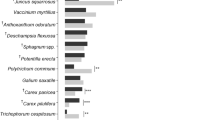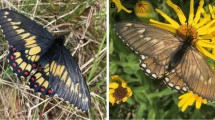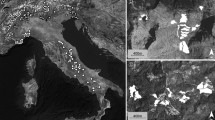Abstract
Recently, it has been suggested that habitats for insect herbivores have been too narrowly defined, often on the basis of larval hostplants; in particular, non-consumable resources (called utilities; structural elements) have been ignored. Here, the importance of utility resources for roosting and mate location has been examined in the silver-studded blue butterfly Plebejus argus (L.) (Lycaenidae) on the Great Ormes Head, North Wales, UK. The methods included using dedicated surveys and correspondence analysis applied to behavioural observations in relation to vegetation structure on a transect through a key patch for this metapopulation model species. A substantial and significant bias in roosting (97%) and mating (75%) is found to occur outside hostplant areas on shrubs and rank bunched grasses and forbs. Population density is higher in shrubby areas and shrubs are increasingly occupied during the afternoons and night, during the late flight season and in cloudy, cool and windy weather. These findings suggest that shrubs are a valuable habitat component for this butterfly, at least at this coastal location, and important for their conservation. As scrub growth is inimical to calcicolous grassland, population status will depend on a fine balance between shrub and hostplant cover dependent on grazing and browsing by the indigenous goat, sheep and rabbit populations as well as on controlled cutting and burning. Opportunities exist for increasing population size and distribution on the headland but this will need to be managed carefully. There are also implications for metapopulation dynamics studies; the status of shrubs neighbouring host plant areas switches from that of barriers to resources and refuges.
Similar content being viewed by others
References
Asher J., Warren M., Fox R., Harding P., Jeffcoate G. and Jeffcoate S. 2001. The Millennium Atlas of Butterflies in Britain and Ireland. Oxford University Press, Oxford.
Caton P.G.F. 1976. Maps of hourly mean wind speed over the United Kingdom 1965-73. Climatological Memorandum 79, Meteorological Office, Bracknell.
Corbet S.A. 2000. Butterfly nectaring flowers: butterfly morphology and flower form. Entomol. Exp Appl. 96: 289-298.
Dennis R.L.H. 1986. Selection of roost sites by Lasiommata megera (L.) (Lep., Satyridae) on fencing at Brereton Heath country park, Cheshire. Nota Lepidopterologica 9: 39-46.
Dennis R.L.H. and Bardell P. 1996. The impact of extreme weather on Great Orme populations of Hipparchia semele (Linnaeus 1758) and Plebejus argus (Linnaeus 1758) (Papilionoidea: Satyrinae and Lycaenidae): hindsight, inference and lost opportunities. Entomol. Gazette 47: 211-225.
Dennis R.L.H. and Shreeve T.G. 1988. Hostplant-habitat structure and the evolution of butterfly mate-location behaviour. Zool. J. Linne. Soc. 94: 301-318.
Dennis R.L.H., Shreeve T.G. and Van Dyck H. 2003. Towards a functional resource-based concept for habitat: a butterfly biology viewpoint. Oikos 102: 417-426.
Dover J.W. 1996. Factors affecting the distribution of satyrid butterflies on arable farmland. J. Appl. Ecol. 33: 723-734.
Dover J.W., Sparks T.H. and Greatorex-Davies J.N. 1997. The importance of shelter for butterflies in open landscapes. J. Insect Conserv. 1: 89-97.
Emmet A.M. and Heath J. (eds), 1990. The butterflies of Great Britain and Ireland. Harley Books, Colchester.
Greenacre M.J. 1984. Theory and Applications of Correspondence Analysis. Academic Press, New York.
Hall L.S., Krausman P.R. and Morrison M.L. 1997. The habitat concept and a plea for standard terminology. Wildl. Soc. Bull. 25: 173-182.
Lewis O.T., Thomas C.D., Hill J.K., Brookes M.I., Crane T.P.R., Graneau Y.A., Mallet J.L.B. and Rose O.C. 1997. Three ways of assessing metapopulation structure in the butterfly Plebejus argus. Ecol. Entomol. 22: 283-293.
Ludwig J.A. and Reynolds J.F. 1988. Statistical Ecology. A primer on methods and computing. John Wiley and Sons, New York.
Mendel H. and Parson E. 1987. Observations on the life-history of the silver-studded blue, Plebejus argus L. Trans. Suffolk. Nat. Soc. 23: 2-8.
Morton A.C.G. 1985. The population biology of an insect with a restricted distribution: Cupido minimus Fuessly (Lepidoptera: Lycaenidae). University of Southampton, UK.
Pollard E. and Yates T.J. 1993. Monitoring butterflies for Ecology and Conservation. Chapman and Hall, London.
Porter K. 1992. Eggs and egg-laying. In: Dennis R.L.H. (ed.), The Ecology of Butterflies in Britain, Oxford University Press, Oxford, pp. 46-72.
Rodwell J.S. (ed.) 1991. British Plant Communities. Cambridge University Press, Cambridge.
Rutowski R.L. 1991. The evolution of male mate-locating behavior in butterflies. The Am. Nat. 138: 1121-1139.
Shreeve T.G. 1992. Adult behaviour. In: Dennis R.L.H. (ed.), The Ecology of Butterflies in Britain. Oxford University Press, Oxford, pp. 22-45.
Statsoft 1999. STATISTICA for Windows 95/98/NT. Tulsa, OK.
Stevens P.A., Bell S.A., Brittain S.A., Hughes S. and Lowe J.A.H. 1995. Soil/plant interactions in lowland grasslands-Great Orme study, Final report. CCW Contract Science Report No. 142. Countryside Council for Wales. [www.ccw.gov.uk].
Thomas C.D. 1985a. Specializations and polyphagy of Plebejus argus (Lepidoptera: Lycaenidae) in North Wales. Ecol. Entomol. 10: 325-340.
Thomas C.D. 1985b. The status and conservation of the butterfly Plebejus argus L. (Lepidoptera: Lycaenidae) in North West Britain. Biol. Conserv. 33: 29-51.
Thomas C.D. and Hanski I. 1997. Butterfly metapopulations. In: Hanski I. and Gilpin M.E. (eds), Metapopulation Dynamics: Ecology, Genetics and Evolution, Academic Press, London, pp. 359-386.
Thomas C.D. and Harrison S. 1992. Spatial dynamics of a patchily distributed butterfly species. J. Anim. Ecol. 61: 437-446.
Waring P. 1995. The status of the silky wave moth Idaea dilutaria (Hubner 1799) in England and Wales in 1994. Regional report (North Wales). Countryside Council for Wales). [www.ccw.gov.uk].
Weidemann H.J. 1988. Tagfalter, 2. Biologie-Ökologie-Biotopschutz. Neumann-Neudamm, Melsungen.
Author information
Authors and Affiliations
Rights and permissions
About this article
Cite this article
Dennis, R.L. Just how important are structural elements as habitat components? Indications from a declining lycaenid butterfly with priority conservation status. Journal of Insect Conservation 8, 37–45 (2004). https://doi.org/10.1023/B:JICO.0000027496.82631.4b
Issue Date:
DOI: https://doi.org/10.1023/B:JICO.0000027496.82631.4b




